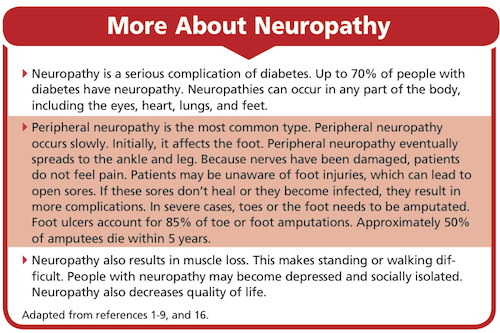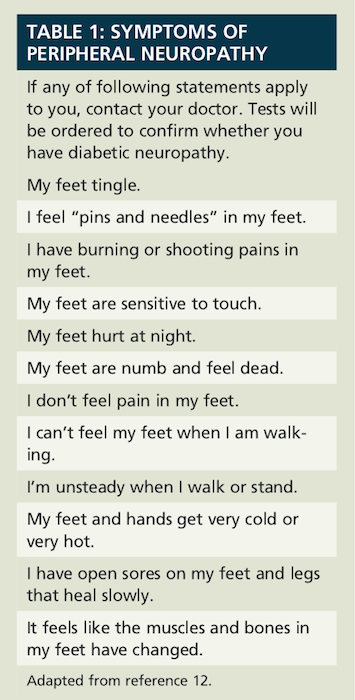Article
Diabetic Neuropathy
Author(s):
Patients with diabetes can take measures to prevent or control neuropathy.
Patients with diabetes can take measures to prevent or control neuropathy.
What Is Diabetic Neuropathy
When you have diabetes mellitus, which is referred to as diabetes, your blood glucose (sugar) level is consistently high. Untreated, a high sugar level damages your nerves. Blood vessels that take oxygen to your nerves are also damaged. Damaged nerves send messages slowly or at the wrong times. Nerves eventually stop sending messages to the brain. This damage is called diabetic neuropathy (see the “More About Neuropathy” insert).

Diabetic neuropathy can occur in both type 1 and type 2 diabetes. In type 1 diabetes, the body does not produce insulin. Insulin is needed to convert glucose into energy that the body needs. Type 2 diabetes is more common. In type 2 diabetes, the body does not use insulin properly. This is called insulin resistance. The body begins to make extra insulin. Over time, the body cannot make enough insulin to keep the glucose level normal.10,11
Table 1 lists symptoms of peripheral neuropathy.

What Factors Increase My Chances of Getting Diabetic Neuropathy?
People with diabetes can develop nerve problems at any time. The risk increases with age. The highest rates of nerve problems are among people who have had diabetes for at least 25 years.
Neuropathies are more common in people who are overweight and have high cholesterol levels. The risk increases when control of their blood glucose level is inadequate. Other risk factors include smoking, heavy alcohol use, and being tall. Having both diabetes and high blood pressure greatly increases the risk for serious complications.9
What Is the Treatment?
There is no cure for neuropathy. Nerve damage cannot be reversed. Treatment focuses on 3 goals. The first is to slow the progression of neuropathy. The second is to relieve pain. The third is to treat complications such as infections. To slow the progression, it is critical to bring blood glucose to a normal level. Glucose monitoring, meal planning, physical activity, and medication help control the glucose level. Good glucose control prevents or delays the onset of future problems.13
For patients with diabetic neuropathy, commonly used medications include antidepressants, anticonvulsants, prescription pain medication, and topical agents. Many of these medications are approved for treating other conditions. They are used because of their positive effects. Antidepressants and anticonvulsants are generally used first. Depending on the medication, side effects may include constipation, dizziness, headache, nausea, dry mouth, fatigue, diarrhea, weight gain, and insomnia.
Medications only partially relieve pain.14 Typically, pain is reduced by 30% to 50%.8 Your doctor may also prescribe medication to lower cholesterol levels. Patients interested in using supplements should first discuss this with their doctor. There is some evidence that L-carnitine and alphalipoic acid help reduce pain.8
What Can I Do to Prevent or Control Diabetic Neuropathy?

Diabetic neuropathy can be prevented or controlled. Monitoring your glucose level and adopting a healthy lifestyle can decrease your risk for neuropathy by as much as 60% (Table 2).5
Dr. Zanni is a psychologist and health systems consultant based in Alexandria, Virginia.
A1C = glycated hemoglobin.
Adapted from references 3, 5, 9, and 15.
Newsletter
Stay informed on drug updates, treatment guidelines, and pharmacy practice trends—subscribe to Pharmacy Times for weekly clinical insights.





